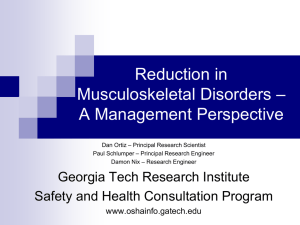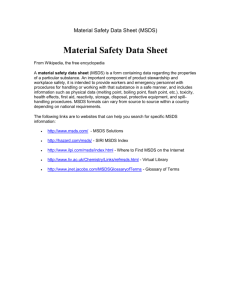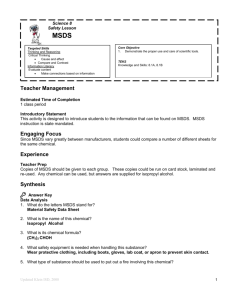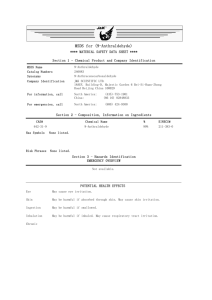Ergonomics Regulatory Script: Preventing Work Injuries
advertisement
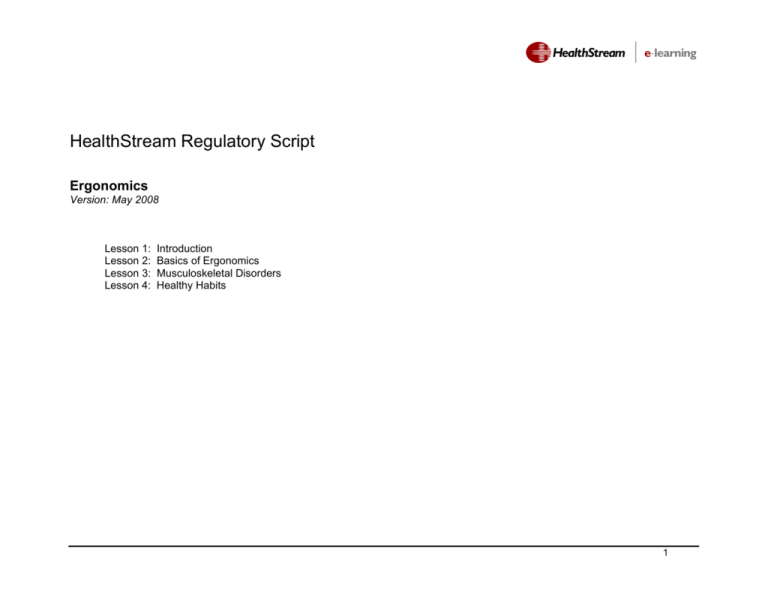
HealthStream Regulatory Script Ergonomics Version: May 2008 Lesson 1: Lesson 2: Lesson 3: Lesson 4: Introduction Basics of Ergonomics Musculoskeletal Disorders Healthy Habits 1 Lesson 1: Introduction 1001 Introduction Welcome to the introductory lesson on ergonomics. IMAGE: 1001.JPG As your partner, HealthStream strives to provide its customers with excellence in regulatory learning solutions. As new guidelines are continually issued by regulatory agencies, we work to update courses, as needed, in a timely manner. Since responsibility for complying with new guidelines remains with your organization, HealthStream encourages you to routinely check all relevant regulatory agencies directly for the latest updates for clinical/organizational guidelines. If you have concerns about any aspect of the safety or quality of patient care in your organization, be aware that you may report these concerns directly to The Joint Commission. Page 1 of 4 1002 Course Rationale IMAGE: 1002.jpg This course will teach you how to avoid work-related repetitive stress injury [glossary] to your: • Wrists • Arms • Back • Other at-risk areas of your body You will learn: • Risk factors for injury • How good ergonomics can protect against injury Page 2 of 4 1003 Course Goals After completing this course, you should be able to: • Define “ergonomics” • Recognize how ergonomics protects against workrelated injury • Identify common types of musculoskeletal disorders (MSDs), including causes, symptoms, and risk factors • Recognize strategies for preventing MSDs • List healthy habits for preventing work-related injury NO IMAGE Page 3 of 4 1004 Course Outline This introductory lesson gave the course rationale and goals. Lesson 2 explains the basics of ergonomics. Lesson 3 discusses musculoskeletal disorders (MSDs). This includes a description of MSDs, risk factors, and preventive strategies. Finally, lesson 4 describes healthy habits that can help keep you safe from injury at work. FLASH ANIMATION: Course Map Lesson 1: Introduction Lesson 2: Basics of Ergonomics • Definition • Importance Lesson 3: Musculoskeletal disorders • Definition • Common types • Risk factors • Symptoms • Preventive Strategies Lesson 4: Healthy Habits Page 4 of 4 Lesson 2: Basics of Ergonomics 2001 Introduction & Objectives Welcome to the lesson on the basics of ergonomics. FLASH ANIMATION: Lesson Map After completing this lesson, you should be able to: • Define “ergonomics” • Recognize the role of ergonomics in preventing work-related injury Lesson 2: Basics of Ergonomics • Definition • Importance Page 1 of 7 2002 Ergonomics IMAGE: 2002.JPG The term “ergonomics” comes from two Greek words: • Ergon, meaning work • Nomos, meaning natural laws Ergonomics means designing work equipment and tasks to fit the “natural laws” of the human body. Page 2 of 7 2003 Ergonomics in the Workplace: Examples Ergonomics should be used throughout the workplace. IMAGE: 2003.jpg Ergonomic principles should be used to design: • Workstations • Controls • Displays • Safety devices • Tools • Lighting • Common tasks Page 3 of 7 2004 Importance of Ergonomics: Injury Why is ergonomics so important? IMAGE: 2004.GIF The body is stressed by awkward and difficult positions and movements. Over time, this stress can lead to injury. This is especially true if: • Awkward or difficult positions are held for long periods of time • Awkward or difficult movements are repeated many times Page 4 of 7 2005 Importance of Ergonomics: Preventing Injury Ergonomics helps prevent work-related injury by helping people avoid awkward and difficult positions and movements. IMAGE: 2005.JPG By preventing work-related injury, an ergonomic work environment can lead to: • A decrease in lost work days • An increase in productivity • Lower worker’s compensation costs • Improved job satisfaction among employees Page 5 of 7 2006 Review Ergonomics means: a. Work-related injuries b. Fitting the human body to the needs of the job c. Fitting the job to the natural laws of the human body d. None of the above MULTIPLE CHOICE INTERACTION [CORRECT ANSWER: C] [RESPONSE FOR CHOICE A: Incorrect. The correct answer is C.] [RESPONSE FOR CHOICE B: Incorrect. The correct answer is C.] [RESPONSE FOR CHOICE C: Correct.] [RESPONSE FOR CHOICE D: Incorrect. The correct answer is C.] Page 6 of 7 2007 Summary You have completed the lesson on the basics of ergonomics. NO IMAGE Remember: • Ergonomics means designing work environments to fit the human body. • Awkward positions and repeated movements can lead to injury. • Ergonomics can help prevent injury by preventing awkward and difficult positions and movements. Page 7 of 7 Lesson 3: Musculoskeletal Disorders 3001 Introduction & Objectives Welcome to the lesson on musculoskeletal disorders (MSDs). FLASH ANIMATION: Lesson Map After completing this lesson, you should be able to: • Define “musculoskeletal disorder” • Identify the types of workers at risk for MSDs • Recognize symptoms and risk factors for MSDs • List strategies for preventing MSDs, including general ergonomic best practices Lesson 3: Musculoskeletal disorders • Definition • Common types • Risk factors • Symptoms • Preventive Strategies Page 1 of 18 3002 Musculoskeletal Disorders due to Repetitive Stress The most common type of work-related injury is the repetitive stress injury (RSI). IMAGE: 3002.JPG RSIs also are known as musculoskeletal disorders (MSDs). MSDs happen when there is ongoing wear and tear on the body. This wear and tear can damage: • Muscles • Tendons • Ligaments • Cartilage • Nerves • Blood vessels Page 2 of 18 3003 MSDs: Severity MSDs vary in severity. IMAGE: 3003.jpg In some people, MSDs cause pain and problems every day. Others have pain and problems only once in a while. Page 3 of 18 3004 MSDs: Who Is at Risk? All workers are at some risk of developing musculoskeletal disorders due to repetitive stress. IMAGE: 3004.JPG However, the risk is higher among certain types of workers. For example, clerical workers are more likely to develop: • Injuries related to repetitive motion of the hands, wrists, and arms • Eyestrain and headache • Back pain Clinical and environmental workers are at high risk for back injury. Page 4 of 18 3005 MSDs in Clerical Workers: Hand, Wrist, & Arm Injury: Causes IMAGE: 3005.jpg Many clerical workers spend at least part of each workday performing repetitive tasks with their hands, for example: • Typing • Filing Over time, this can result in injury to the: • Hand • Wrist • Arm Page 5 of 18 3006 MSDs in Clerical Workers: Hand, Wrist, & Arm Injury: Common Types Three common hand and arm injuries seen in clerical workers are: • Carpal tunnel syndrome • DeQuervain’s tenosynovitis • Bursitis Click on the name of each MSD to learn more. CLICK TO REVEAL Carpal tunnel syndrome Carpal tunnel syndrome (or CTS) happens when a nerve becomes pinched at the wrist. Painful, burning numbness in the palm of the hand is a common symptom. Numbness generally awakens the patient at night or happens with repetitive use of the hand. Pain may radiate up the arm toward the shoulder. Loss of strength in the hand also is a common symptom. DeQuervain’s tenosynovitis Tendons are the rope-like structures that connect muscles to bone. The synovial sheath is the protective lining around tendons. Tenosynovitis is inflammation of tendons and the surrounding synovial sheath. DeQuervain’s or stenosing tenosynovitis affects the tendons on the thumb side of the wrist. Symptoms include aching, tenderness, swelling, and shooting pain. Bursitis Bursae are small, fluid-filled sacs that allow bones to glide smoothly against moving structures such as muscles and tendons. Bursitis is the inflammation of a bursa. Symptoms of bursitis include pain and stiffness aggravated by movement. Pain may be prominent at night. Almost any bursa in the body can be affected, but those located around a joint are affected most often. Page 6 of 18 3007 MSDs in Clerical Workers: Hand, Wrist, and Arm Injury: Prevention To help prevent MSDs in the hand, wrist, and arm: • Avoid awkward wrist positions • Reduce repetitive hand movements • Minimize the use of vibrating tools • Redesign tools and workstations to maintain a neutral hand position • Add variety to tasks • Take frequent breaks • Use wrist supports • Adjust desk height IMAGE: 3007.JPG Page 7 of 18 3008 MSDs in Clerical Workers: Back Pain: Causes Causes of back pain in clerical workers include: • Sitting with poor posture • Sitting in poorly designed chairs • Sitting in chairs that are not adjusted properly IMAGE: 3008.jpg Sitting is a static posture that can stress the back, neck, arms, and legs. This puts pressure on the back muscles and the spine. People who sit for long periods also may have swelling or tension in muscles of the buttocks. This puts pressure on the sciatic nerve, causing pain. Page 8 of 18 3009 MSDs in Clerical Workers: Back Pain: Prevention To help prevent back pain as a result of prolonged sitting: • Use an ergonomically designed chair • Place your chair at the proper height. Your feet should rest flat on the floor or on a support. • Distribute your body weight evenly on both hips. • Bend your knees at a right angle. Keep your knees even with or slightly higher than your hips. • Sit with your back straight and shoulders back. • Avoid sitting in the same position for more than 30 minutes at a time. IMAGE: 3009.JPG Page 9 of 18 3010 MSDs in Clerical Workers: Eye Problems: Types Computer use has not been shown to cause permanent injury to the eyes. IMAGE: 3010.JPG However, computer users often have temporary problems with eyestrain and headaches. Other eye problems can include: • Double or blurred vision • Burning or dry feeling in the eyes • Eye fatigue • Loss of focus Page 10 of 18 3011 MSDs in Clerical Workers: Eye Problems: Prevention To help prevent computer-related eye problems: • Have your eyes checked by an eye doctor regularly • Rest your eyes for at least 20 seconds every 30 minutes • Clean your monitor screen regularly • Keep your monitor 18 to 24 inches from your face • Adjust lighting to reduce glare on your screen • Use an anti-glare screen if necessary IMAGE: 3011.JPG Page 11 of 18 3012 MSDs in Clinical & Environmental Workers: Back Injury: Introduction Clinical staff and environmental workers often do a lot of lifting. IMAGE: 3012.GIF This puts them at high risk for back injury. Page 12 of 18 3013 MSDs in Clinical & Environmental Workers: Back Injury: Risk Factors For clinical workers, a significant risk factor for back injury is not using the right device to assist with patient lifts and transfers. IMAGE: 3013.JPG Other risk factors for back injury when lifting are: • Poor posture • Poor physical condition • Improper body mechanics • Lifts that take a lot of force Page 13 of 18 3014 MSDs in Clinical & Environmental Workers: Back Injury: Prevention To help prevent back injury related to lifting and transferring patients: • Always use the proper device (e.g., gait belt, transfer board, etc.) for the transfer • Always use enough staff members to do the transfer safely IMAGE: 3014.jpg Other ways to prevent back injury when lifting include: • Maintain proper body alignment • Lift with the knees, keeping the back straight • Wear slip-resistant shoes • Keep lifted loads close to the body • Take breaks and stretch often Page 14 of 18 3015 General Tips for Preventing MSDs: Ergonomic Best Practices Regardless of the type of work you do, use the following best practices to help prevent MSDs: • Avoid fixed or awkward postures • Avoid manual lifting whenever possible (i.e., use carts and lifting devices instead) • Avoid highly repetitive tasks • Avoid using a lot of force • Provide support for your limbs • Use the ergonomic tools supplied by your facility (e.g., wrist supports for keyboards) NO IMAGE Page 15 of 18 3016 General Tips for Preventing MSDs: Regular Exercise Regular exercise can help prevent injury and illness of all types. IMAGE: 3016.JPG Always consult your physician before starting an exercise program. Page 16 of 18 3017 Review Roll over the parts of Jane’s body where repetitive motion injuries are most likely to occur. FLASH INTERACTION: 3017.SWF Page 17 of 18 3018 Summary You have completed the lesson on musculoskeletal disorders. NO IMAGE Remember: • All workers are at risk for work-related MSDs. • The risk of MSDs is greater among certain workers. These include clerical workers, clinical staff, and environmental personnel. • Use ergonomic best practices and other appropriate strategies to help prevent MSDs. Page 18 of 18 Lesson 4: Healthy Habits 4001 Introduction & Objectives Welcome to the lesson on healthy habits. FLASH ANIMATION: Lesson Map After you have completed this lesson, you will be able to: • List eight healthy habits that can help reduce the risk of injury in the workplace Lesson 4: Healthy Habits Page 1 of 11 4002 Healthy Habit 1 Follow your facility’s policies and procedures. IMAGE: 4002.JPG Take the time to review information on safe work practices. If you have any questions or need explanation, see your supervisor. Page 2 of 11 4003 Healthy Habit 2 IMAGE: 4003.JPG Know your equipment. You should know about each item of equipment that you use. Know the answers to these questions: • How does the equipment work? • Can I adjust the equipment to better fit me? . Page 3 of 11 4004 Healthy Habit 3 Keep your tools close. IMAGES: 4004.jpg Keep the tools you use often right in front of you. This can help reduce: • Twisting motions • Stress to the arms, shoulders, and back • Awkward stretching and bending while searching for items Page 4 of 11 4005 Healthy Habit 4 Maintain neutral positions. IMAGE: 4005.jpg Neutral positions are the natural postures of the body. Neutral positions are especially important when performing repetitive tasks. Page 5 of 11 4006 Healthy Habit 5 Take advantage of supportive equipment. IMAGE: 4006.jpg Your facility supplies special equipment and tools to help: • Provide support for repetitive work • Reduce the risk of MSDs Common examples of supportive equipment include: • Keyboard wrist supports • Gait belts for lifting • Document holders and stands for visual comfort • Ergonomically designed chairs for back support Page 6 of 11 4007 Healthy Habit 6 Respond to your aches and pains. IMAGE: 4007.JPG Aches and pains are the early signs of injury. Ignoring pain may result in a more serious injury that is: • Harder to treat • Slower to heal Pay serious attention to any persistent: • Soreness • Weakness • Numbness • Tingling If you experience any of these signs or symptoms, contact your physician to check out the problem as soon as possible. Page 7 of 11 4008 Healthy Habit 7 Modify high-risk work habits. IMAGE: 4008.JPG High-risk behaviors increase the chance of injury. Examples are: • Sitting or standing in one position for too long • Incorrect hand or wrist position when typing • Leaning on the elbows and wrists • Holding the head down and forward • Slouching when sitting (i.e., poor posture) Work on correcting these bad habits. Page 8 of 11 4009 Healthy Habit 8 Review hobbies and chores at home. IMAGE: 4009.GIF Bad habits at home often carry over to work, and vice versa. Page 9 of 11 4010 Review Arrange items on the desk to avoid the stress of reaching, twisting, and stretching. • Pen • Telephone • Stamp • Envelope • Plant • Family photograph • Mouse FLASH INTERACTION: 4010.SWF Click on each item and drag it to the appropriate work surface. Page 10 of 11 4011 Summary You have completed the lesson on healthy habits. NO IMAGE Remember: • Follow your facility’s policies and procedures • Know your equipment • Keep your tools close by • Maintain neutral positions • Take advantage of supportive equipment • Respond to aches and pains • Modify high-risk work habits • Practice good habits at home Page 11 of 11 Course Glossary # Term carpal tunnel syndrome cartilage ligament muscle musculoskeletal disorder nerves OSHA (Occupational Safety and Health Administration) repetitive stress injury sciatica tendon Definition painful and sometimes disabling condition involving compression of the median nerve as it passes through the carpal tunnel, a rigid compartment formed by the carpal bones of the hand at the base of the palm tough, elastic, fibrous connective tissue found in various parts of the body, such as the joints, outer ear, and larynx sheet or band of tough, fibrous tissue connecting bones or cartilages at a joint or supporting an organ tissue composed of fibers capable of contracting to effect bodily movement any disease, injury, or significant impairment to muscles, bones, joints, or supporting connective tissues any of the cordlike bundles of fibers made up of neurons through which sensory stimuli and motor impulses pass federal agency responsible for national regulations that ensure a safe workplace type of injury sustained over time due to repeating the same task or movement over and over again; also referred to as musculoskeletal disorder pain along the sciatic nerve, usually caused by a herniated disk of the lumbar region of the spine band of tough, inelastic, fibrous tissue connecting a muscle with its bony attachment Pre-Assessment 1. The best definition for ergonomics is: a. Following "natural laws" in assigning work to employees b. Defining "natural laws" according to the needs of a project c. Considering the "natural laws" of the human body in designing work equipment d. Obeying the "natural laws" of momentum and leverage in performing work-related tasks Correct: Considering the "natural laws" of the human body in designing work equipment Rationale: Ergonomics is the practice of designing work equipment and tasks to suit the "natural laws" of the human body. 2. Awkward and difficult positions and movements are a risk factor for injury. The risk is increased if these positions and movements: a. b. c. d. Are repeated many times Are not part of a person's everyday work Are performed using ergonomic equipment Are within a person's ordinary range of motion Correct: Are repeated many times Rationale: Repetitive movement is a risk factor for injury. 3. Another name for a musculoskeletal disorder (MSD) is: a. Multiple sclerosis (MS) b. Muscular dystrophy (MD) c. Repetitive stress injury (RSI) d. Posttraumatic stress disorder (PTSD) Correct: Repetitive stress injury (RSI) Rationale: MSDs often result from repeated movements that cause wear and tear on the body. Therefore, MSDs are also called repetitive stress injuries. 4. With regard to severity, musculoskeletal disorders (MSDs): a. Range in severity b. Always cause pain and problems every day c. Only cause pain and problems once in a while d. Are never severe enough to require a change of jobs Correct: Range in severity Rationale: MSDs range in severity. They can be very severe. Therefore, it is important to respond promptly to symptoms. 5. In the healthcare setting, workers at greatest risk for musculoskeletal disorders (MSDs) affecting the wrist are: a. Volunteers b. Clinical workers c. Clerical workers d. Environmental workers Correct: Clerical workers Rationale: As a group, clerical workers are at greatest risk for wrist injury. This is due to repetitive tasks such as typing and filing. 6. Activities that DECREASE risk of musculoskeletal disorders (MSDs) for clerical workers are: a. Avoiding a wide variety of tasks b. Working on a single task without breaks c. Spending a lot of time on typing and filing tasks d. Maintaining a neutral hand position during tasks Correct: Maintaining a neutral hand position during tasks Rationale: Neutral body positions decrease the risk of MSDs. 7. Which of the following is an ergonomic best practice to prevent back pain and injury from prolonged sitting? a. Keep the shoulders over the hips. b. Shift body weight from hip to hip every ten to 15 minutes. c. Place feet flat on the floor so that the knees are lower than the hips. d. Round the shoulders forward to press the low back into the chair's back support. Correct: Keep the shoulders over the hips. Rationale: To help prevent back pain from prolonged sitting, maintain good posture. Keep the back straight and the shoulders over the hips. 8. Computer users can develop eyestrain and headaches. To help avoid these problems, keep your computer monitor: a. 12 to 18 inches from your face b. 18 to 24 inches from your face c. No less than 24 inches from your face d. No more than 12 inches from your face Correct: 18 to 24 inches from your face Rationale: To avoid eyestrain and headaches from computer use, keep your computer monitor 18 to 24 inches from your face. 9. Clinical and environmental workers are at risk for back pain and injury primarily because they: a. Do a lot of lifting b. Sit for long periods c. Perform a variety of different tasks d. Maintain neutral back positions during most of their tasks Correct: Do a lot of lifting Rationale: Repetitive lifting puts clinical and environmental workers at risk for back pain and injury. 10. Which of the following is a healthy habit that can help reduce the risk of injury in the workplace? a. Respond promptly to aches and pains b. Keep tools at a distance from your workspace c. Hold the head down and forward when working at a desk d. Maintain joints in highly flexed positions whenever possible Correct: Respond promptly to aches and pains Rationale: Always respond promptly to aches and pains. This can help ensure that temporary pain does not develop into a chronic injury. Final Exam 1. When work equipment and tasks are designed ergonomically, they take into account: a. The "natural laws" of the human body b. The laws related to worker's compensation c. The "economic laws" of supply and demand d. The "unwritten laws" of employee satisfaction Correct: The "natural laws" of the human body Rationale: Ergonomics is the practice of designing work equipment and tasks to suit the human body. 2. An ergonomic work environment can help prevent work-related injury by: a. Fitting the human body to the needs of the job b. Helping workers repeat movements more rapidly c. Helping workers avoid awkward and difficult movements d. Fitting the human body to the constraints of small spaces Correct: Helping workers avoid awkward and difficult movements Rationale: Awkward and difficult movements are a risk factor for injury. An ergonomic work environment can help workers avoid these types of movements. 3. Musculoskeletal disorders (MSDs) happen when: a. A person is born with a genetic disease. b. A person fractures a bone due to sudden trauma. c. A person has brittle bones, which are at risk for damage from impact. d. A person repeats certain movements, which cause wear and tear on the body. Correct: A person repeats certain movements, which cause wear and tear on the body. Rationale: MSDs result from repetitive stress on the body. 4. Choose the true statement regarding healthcare workers and risk of musculoskeletal disorders (MSDs): a. Clerical workers have the least risk of eyestrain. b. Clinical workers are at increased risk for back injury. c. Environmental workers have the highest risk of all MSDs. d. Clinical and environmental workers have the highest risk of wrist injury. Correct: Clinical workers are at increased risk for back injury. Rationale: Both clinical and environmental workers have an elevated risk for back injury. This is primarily because these types of workers do a lot of lifting. 5. A practice that INCREASES risk of musculoskeletal disorders (MSDs) for clerical workers is: a. Using ergonomic seating b. Doing a variety of different tasks c. Spending a lot of time on typing and filing tasks d. Maintaining a neutral hand position during tasks Correct: Spending a lot of time on typing and filing tasks Rationale: Repetitive typing and filing is a risk factor for injury for clerical workers. 6. Clerical workers are at risk for back pain and injury primarily because they: a. Sit for long periods b. Do a lot of typing and filing c. Perform a variety of different tasks d. Maintain neutral back positions during most of their tasks Correct: Sit for long periods Rationale: Sitting for long periods is a risk factor for back pain and injury for clerical workers. 7. Which of the following practices is most likely to contribute to back pain from prolonged sitting? a. Distribute body weight evenly over both hips. b. Keep the back straight and the shoulders over the hips. c. Place feet flat on the floor so that the knees are level with or slightly higher than the hips. d. After establishing the position of the knees, hips, and shoulders, maintain this fixed position until the work is finished. Correct: After establishing the position of the knees, hips, and shoulders, maintain this fixed position until the work is finished. Rationale: Maintaining the same seated position for long periods is a risk factor for injury. To help prevent pain and injury, get up and stretch periodically. 8. Computer users can develop eyestrain and headaches. To help avoid these problems, a recommended practice is to rest your eyes for at least: a. 10 seconds every 10 minutes b. 20 seconds every 30 minutes c. 30 seconds every 40 minutes d. 60 seconds every 60 minutes Correct: 20 seconds every 30 minutes Rationale: To help avoid eyestrain and headaches, computer users should rest their eyes for at least 20 seconds every 30 minutes. 9. To help prevent back injury related to lifting and moving patients, the single most important practice is: a. Use the proper device for the transfer b. Hold the patient at a distance from the body c. Allow the back to round during the lifting motion d. Lift primarily using the muscles of the arms and shoulders Correct: Use the proper device for the transfer Rationale: A significant risk factor for injury during patient transfers is not using the proper device. Always use the proper device for transfers. 10. Which of the following is a healthy habit that can help reduce the risk of injury in the workplace? a. Keep tools at a distance from your workspace b. Hold the head down and forward when working at a desk c. Know your equipment and facility policies and procedures d. Maintain joints in highly flexed positions whenever possible Correct: Know your equipment and facility policies and procedures Rationale: To avoid injury in the workplace, know your equipment. Also be sure you know facility policies and procedures for the work that you do.

